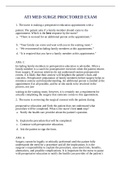Summary
Summary Chapter 4: The Monetary System - What is it and How does it work?
- Course
- Macro Economics (ECC201)
- Institution
- Nelson Mandela Metropolitan University (NMMU)
- Book
- Macroeconomics
This document is a summary that comprises of information gathered from the prescribed textbook.
[Show more]













